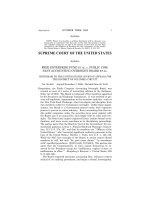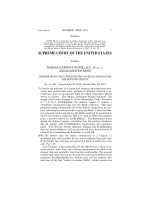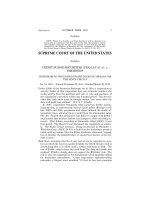EVALUATION OF THE IRISPLEX DNA-BASED EYE COLOR PREDICTION TOOL IN THE UNITED STATES
Bạn đang xem bản rút gọn của tài liệu. Xem và tải ngay bản đầy đủ của tài liệu tại đây (11.02 MB, 170 trang )
Graduate School ETD Form 9
(Revised 12/07)
PURDUE UNIVERSITY
GRADUATE SCHOOL
Thesis/Dissertation Acceptance
This is to certify that the thesis/dissertation prepared
By
Entitled
For the degree of
Is approved by the final examining committee:
Chair
To the best of my knowledge and as understood by the student in the Research Integrity and
Copyright Disclaimer (Graduate School Form 20), this thesis/dissertation adheres to the provisions of
Purdue University’s “Policy on Integrity in Research” and the use of copyrighted material.
Approved by Major Professor(s): ____________________________________
____________________________________
Approved by:
Head of the Graduate Program Date
Gina Dembinski
Evaluation of the IrisPlex DNA-based eye color prediction tool in the United States
Master of Science
Christine Picard
Stephen Randall
John Goodpaster
Christine Picard
Christine Picard
06/13/2013
EVALUATION OF THE IRISPLEX DNA-BASED EYE COLOR PREDICTION
TOOL IN THE UNITED STATES
A Thesis
Submitted to the Faculty
of
Purdue University
by
Gina M. Dembinski
In Partial Fulfillment of the
Requirements for the Degree
of
Master of Science
August 2013
Purdue University
Indianapolis, Indiana
ii
ACKNOWLEDGMENTS
I am grateful to have had the opportunity to work on this project, and to the School of
Science start-up funds for allowing it to be possible. Dr. Picard, I really cannot begin to
express the appreciation for all the challenges and supportive criticism in helping me
pursue to my goals and to become a better scientist. I am very fortunate to have you as a
mentor. Thank you for also allowing me to stick around for the next years and continue
developing this project.
I also want to extend thanks to all others who helped me during this research process,
some may not even know the extent to which they did; you have my sincerest gratitude.
iii
TABLE OF CONTENTS
Page
LIST OF TABLES iv
LIST OF FIGURES v
LIST OF ABBREVIATIONS vi
ABSTRACT viii
CHAPTER 1. INTRODUCTION 1
1.1 Iris Structure 4
1.2 Pigmentation and Melanogenesis 5
1.3 Pigmentation Genes and Informative SNPs 7
CHAPTER 2. METHODOLOGY 13
2.1 Sample Collection 13
2.2 DNA Extraction and Quantitation 13
2.3 SNP Amplification and Genotyping 14
2.4 Iris Color Determination and Measurement 17
2.4.1 Color Components 17
2.4.2 Objective Color Classification 19
2.5 Statistical Phenotype Prediction Models 20
2.5.1 Multinomial Logistic Regression Model 20
2.5.2 Bayesian Network Model 22
2.5.3 Linear Discriminant Analysis 23
CHAPTER 3. IRISPLEX EVALUATION: RESULTS AND DISCUSSION 26
3.1 Eye Color Determination 26
3.2 Multinomial Logistic Regression Analysis 28
3.3 Bayesian Network Analysis 33
3.4 Genetic Variation within the U.S. Population 34
3.5 Evaluation of Samples with Conflicting Eye Classification 38
CHAPTER 4. CONCLUSIONS AND FUTURE CONSIDERATIONS 41
REFERENCES 44
PERMISSIONS 52
APPENDICES
Appendix A. SNP Genotype Profiles and Eye Color Classification 59
Appendix B. MLR Prediction Probabilities 65
Appendix C. BN Prediction Probabilities 72
Appendix D. BN Likelihood Ratios 78
Appendix E. Digital Photo Collection 84
Appendix F. SNP Profile Electropherograms 91
iv
LIST OF TABLES
Table Page
Table 2.1 Modified IrisPlex SNP primer concentrations 16
Table 2.2 The regression parameters for the multinomial logistic regression of the
original IrisPlex model and our adjusted frequency model 22
Table 3.1 Percentage of samples determined for each eye color category 27
Table 3.2 Eye color distribution among sample population and larger scale United
States sample population 28
Table 3.3 The correct prediction rates by color category of all 200 samples
evaluated for each prediction model 30
Table 3.4 AUC values of each prediction model 31
Table 3.5 Prediction model performance test characteristics of both regression and
Bayesian parameter sets after analysis of our 200 samples 35
Table 3.6 SNP allele frequency comparison 36
Table 3.7 Eye color distribution among 11 states 37
Table 3.8 The 22 samples with conflicting visual and objective color classifications 39
Table 3.9 Comparison of the number of correct predictions of the 22 samples that
differed in visual and quantitative eye color classification 40
v
LIST OF FIGURES
Figure Page
Figure 1.1 Transverse view of the human iris 5
Figure 1.2 Illustration of melanogenesis 7
Figure 1.3 HERC2-OCA2 interaction 10
Figure 2.1 Outline of single base extension (SBE) 15
Figure 2.2 Iris digital photo sample 18
Figure 2.3 The IMI formula 19
Figure 2.4 Outline of the Bayesian network nodal relationship 23
Figure 3.1 DA scatterplot of xy color coordinates 29
Figure 3.2 The frequency of overall correct, incorrect, and inconclusive eye color
predictions using the MLR model 32
Figure 3.3 The frequency of overall correct, incorrect, and inconclusive eye color
predictions using the BN model 33
vi
LIST OF ABBREVIATIONS
®
registered
°C
degrees Celsius
α
alpha
α-MSH
alpha-melanocyte stimulating hormone
β
beta
μL
microliter
μM
micromolar
χ
2
chi-squared test
ALFRED
allele frequency database
ASIP
agouti signaling protein
ATP
adenosine triphosphate
AUC
area under receiver operating characteristic curve
BMV
bureau of motor vehicles
BN
Bayesian network
cAMP
cyclic adenosine monophosphate
CIELAB
International Commission on Illumination
L*a*b* color space
CODIS
Combined DNA index system
CV
canonical variate
DA
discriminant analysis
DCT
dopachrome tautomerase
ddNTP
dideoxynucleotide
df
degrees of freedom
DNA
deoxyribonucleic acid
dNTP
deoxynucleotide
DOPA
3,4,-dihydroxylphenylalanine
EM
eumelanin
EVC
externally visible characteristic
FBI
Federal Bureau of Investigation
GWAS
genome-wide association study
HERC2
HECT and RLD domain containing E3 ubiquitin protein ligase 2
HGDP-CEPH
human genome diversity panel-center for the study of human
polymorphisms
vii
hr
hour
IMI
iris melanin index
IRF4
interferon regulatory factor 4
MATP
membrane associated transporter protein
MC1R
melanocortin 1 receptor
MITF
microphthalmia transcription factor
mL
milliliter
MLR
multinomial logistic regression
ng
nanogram
NPV
negative predictive value
OCA2
oculocutaneous albinism II gene
P
human homologue of mouse pink eyed dilution gene
PCR
polymerase chain reaction
PHR
peak height ratio
PKA
protein kinase A
PM
pheomelanin
PPV
positive predictive value
rfu
relative fluorescent units
RGB
red green blue
ROC
receiver operating characteristic curve
rpm
revolutions per minute
SAP
shrimp alkaline phosphatase
SBE
single base extension
SLC24A5
solute carrier family 24 member 5
SLC24A5
solute carrier family 24 member 5
SLC45A2
solute carrier family 45 member 2
SNP
single nucleotide polymorphism
STR
short tandem repeat
TYR
tyrosinase gene
TYRP1
tyrosinase related protein 1
™
trademark
UV
ultraviolet radiation
viii
ABSTRACT
Dembinski, Gina M. M.S., Purdue University, August 2013. Evaluation of the IrisPlex
DNA-Based Eye Color Prediction Tool in the United States. Major Professor: Christine J.
Picard.
DNA phenotyping is a rapidly developing area of research in forensic biology.
Externally visible characteristics (EVCs) can be determined based on genotype data,
specifically from single nucleotide polymorphisms (SNPs). These SNPs are chosen
based on their association with genes related to the phenotypic expression of interest,
with known examples in eye, hair, and skin color traits. DNA phenotyping has forensic
importance when unknown biological samples at a crime scene do not result in a criminal
database hit; a phenotype profile of the sample can therefore be used to develop
investigational leads. IrisPlex, an eye color prediction assay, has previously shown high
prediction rates for blue and brown eye color in a European population. The objective of
this work was to evaluate its utility in a North American population. We evaluated the
six SNPs included in the IrisPlex assay in an admixed population sample collected from a
U.S.A. college campus. We used a quantitative method of eye color classification based
on (RGB) color components of digital photographs of the eye taken from each study
volunteer and placed in one of three eye color categories: brown, intermediate, and blue.
Objective color classification was shown to correlate with basic human visual
ix
determination making it a feasible option for use in future prediction assay development.
In the original IrisPlex study with the Dutch samples, they correct prediction rates
achieved were 91.6% for blue eye color and 87.5% for brown eye color. No intermediate
eyes were tested. Using these samples and various models, the maximum prediction
accuracies of the IrisPlex system achieved was 93% and 33% correct brown and blue eye
color predictions, respectively, and 11% for intermediate eye colors. The differences in
prediction accuracies is attributed to the genetic differences in allele frequencies within
the sample populations tested. Future developments should include incorporation of
additional informative SNPs, specifically related to the intermediate eye color, and we
recommend the use of a Bayesian approach as a prediction model as likelihood ratios can
be determined for reporting purposes.
1
CHAPTER 1. INTRODUCTION
When biological material is left at a crime scene, ultimately the purpose of the
forensic analysis of that evidence is to obtain a DNA profile. DNA profiling is
considered the gold standard of forensic science because it allows for reliable individual
identification with statistical support [3]. DNA profiling is currently based on the
exploitations of the genetic variations within each individual’s DNA, known as short
tandem repeats (STR). Once generated from the biological material, the STR profiles
from crime scene samples can then be used for comparison between putative individuals.
One method is through searching DNA databases for possible lists of suspects.
Currently, the main database is maintained by the Federal Bureau of Investigation (FBI),
a database called the Combined DNA Index System (CODIS). There are also databases
at local and state levels, but these feed into the national database. The profiles are
currently based on 13 core STR loci (markers) [4]. There are close to 11 million profiles
that exist in the national database (C. Sobieralski, Indiana State Police, personal
communication).
There have been improvements in the sensitivity of STR testing where DNA profiles
are now routinely obtained from minute quantities of biological material not visible to the
naked eye [5]. However, the limitation of DNA evidence is when a DNA profile from a
crime scene fails to match any one individual from a DNA database. FBI CODIS
2
statistics showed that DNA profiles increased exponentially from 2001-2006, yet hits
increased linearly which leads to an increasing discrepancy between unmatched DNA
profiles and hits [6]. At this time, a DNA profile does not provide any informative
characteristics of the contributor other than the sex of the individual. Therefore, an
unknown suspect(s) can never be identified using the current genetic markers in forensic
DNA profiling [7]. One way to overcome this limitation is to obtain additional genetic
information from the biological material to complement the STR profile. One of the
rapidly developing areas in forensic biology is the ability to predict externally visible
characteristics (EVC) of an individual based on DNA-based genetic information, known
as DNA phenotyping [8]. In DNA phenotyping, single nucleotide polymorphism (SNP)
markers, as opposed to STR markers, are found associated with EVC genes, and can be
typed for the prediction of a particular phenotype prediction purposes [7]. Human sex
determination is an accurately predicting EVC that is currently in use with existing DNA
profiles [7]. In 2001, Grimes et al. [6] published the first example of a phenotype
prediction test showing that variants in the MC1R gene was indicative of the red hair
phenotype [2]. EVCs that show the most promise for the successful development of
forensic prediction tests in the near future are skin, hair, and eye color; they are among
the most visible phenotypic traits [9] and have a small number of markers that account
for a large proportion of the variation [6].
As a complement to conventional STR profiling, DNA phenotyping can be used as an
investigational tool, not just for criminal casework, but also those pertaining to missing
persons or mass disasters [8]. For example, the information from a DNA phenotype
profile will either corroborate or negate eye witness statements [8]. This has been
3
demonstrated in a criminal investigation to aid in a Louisiana serial killer case in 2003.
DNAPrint Genomics, a genetic testing company, had developed an ancestry phenotype
test called DNAWitness 1.0, which included 71 informative ancestry informative markers
(AIMs) [10]. Eyewitness testimony had suggested a Caucasian assailant, and after
finding no leads, the task force commissioned the DNAWitness testing, where the results
suggested the contributor was predominantly African. A month later, the suspect,
Derrick Todd Lee, an African-American male, was arrested and has since been convicted
in two murders [10]. Once developed fully for forensic applications, the information
possible from these predictions may help in developing plausible leads for investigations,
especially in cases when they are limited.
The full genetic determination of externally visible traits is still being explored;
however, many studies have identified genes and SNPs of interest that contribute to
variation in pigmentation, such as eye, hair, or skin color, which results in differences of
the expressed traits [2, 9, 11-19]. Melanin production and distribution is especially found
to affect the expression of these phenotypes, thus the SNPs associated with pigmentation
gene loci can be useful for the development of prediction models.
The objective of this work was to evaluate a previously developed DNA-based
phenotyping assay that predicts eye color, called IrisPlex, as an informative forensic tool
to be used within the United States. IrisPlex includes an assay of six eye color
informative SNPs and a statistical model for predicting iris color. IrisPlex has been
validated for several European populations [20, 21] in predicting blue and brown eye
color, but still lacked evaluation with more admixed individuals, such as those in the U.S.
population. In this current study, adjusted and alternative prediction models were also
4
tested, and quantitative color measurement for determining iris color was also applied as
an objective color classification method.
1.1 Iris Structure
Human eye color expression is based on genetic, developmental, molecular, and
morphological features of the iris [1]. The stroma and anterior layer of the iris have been
shown to be the most important structural cell layers for eye color appearance and contain
pigment cells (see Figure 1.1) [1]. Pigment cells are called melanocytes. Stromal
melanocytes have the same embryological origin as dermal melanocytes, and they
migrate through the uveal tract during development [1]. The iris pigmented epithelium
(IPE), the posterior layer, is always pigmented regardless of eye color, except in
individuals who exhibit albinism [1]. The stromal layer consists of loose connective
tissue made of fibroblasts, melanocytes, and several collagen fibril proteins [1]. It has
been shown that approximately 66% of the stromal composition is made of melanocytes,
regardless of eye color; no statistical significance is seen in the total mean melanocyte
number (the same cell density among different color groups) [22]. Unlike hair and skin
where melanin (pigment) is continuously produced and secreted, melanosomes in the iris
are retained in the iris (stroma) [1]. Three factors considered the major determining
factors of the appearance of iris color are: pigment granules in the iris pigment epithelium
(IPE), concentration of pigment in stromal melanocytes, and light scattering and
absorptive properties of extracellular components [23].
5
1.2 Pigmentation and Melanogenesis
Melanin is a indole derivative of 3,4 di-hydroxy-phenylalanine (DOPA) and is
formed from tyrosine in a series of oxidative steps [24]. The major known function of
melanin is protection against UV-induced DNA damage as it absorbs and scatters the UV
radiation [24]. Variation in the expression of human pigmentation is described by
differences in the type of melanin, the amount of melanin synthesized in melanosomes
(specialized vesicles) and the size, shape, and export of melanosomes to the hair, skin,
and iris [6]. There are two types of melanin, eumelanin (EM) and pheomelanin (PM)
which differ mainly in sulfur content [6]. Most melanin pigments present in hair, skin,
and eyes are complex heteropolymers made up of both EM and PM building blocks, not a
homopolymer of one or the other [25]. Eumelanin is a brown/black pigment and
pheomelanin is a yellow/red pigment. A study on cultured uveal melanocytes
demonstrated a trend in the type of melanin and eye color. Dark iris colors have a greater
amount of EM, intermediate iris colors (i.e., green) have more PM and the lighter eye
Figure 1.1. Transverse view of the human iris [1]. The five structural layers of the iris
can be seen. Reproduced with permission from Springer Science and Business Media.
6
colors, such as blue, have very little of either pigment [23]. The formation of pupillary
rings (brown around blue, brown around green) are not yet genetically understood [26].
Melanogenesis is illustrated in Figure 1.2. The first step in melanin formation is
oxidation of tyrosine to L-DOPA, this is known as the Raper-Mason pathway [24]. L-
DOPA activates the enzyme tyrosinase. Mutations of tyrosinase affecting its function
lead to forms of oculocutaneous albinism, hereditary disorders resulting in melanin
deficiency (or absence) [24]. The pathway begins with the α-melanocyte stimulating
hormone (α-MSH) binding to the melanocortin 1 receptor (MC1R). Melanocortin
receptors have seven transmembrane domains and are a group belonging to the G-protein
coupled receptor superfamily; MC1R is expressed in melanocytes [24]. This binding of
α-MSH leads to a G-protein dependent activation of adenylate cyclase and increases
cAMP levels to activate protein kinase A (PKA) [24]. PKA induces the microphthalmia
transcription factor (MITF) [24]. The MITF regulates transcription of tyrosinase and of
Rab27a, which is an important protein in melanosome transport [24]. Tyrosinase, once
activated, acts on tyrosine to make dopaquinone and addition of cysteine if present [2].
When cAMP is limited, pheomelanin formation is favored [2]. Tyrosine related protein I
(TYRP1) is stimulated by MITF along with dopachrome tautomerase (DCT) which will
lead to eumelanin production as long as the following required proteins Pmel17, MATP,
P, and SLC24A5 are present, all which are important to transport and maturation of the
melanosome structure [2].
7
1.3 Pigmentation Genes and Informative SNPs
Common variants associated with normal pigmentation in humans have thus far been
identified currently by genome-wide association studies (GWAS) in six genes: MC1R,
OCA2, SLC24A5, MATP (SLC45A2), ASIP, and TYR [9]. The MC1R gene relates to the
MC1R receptor in the melanogenesis pathway. The OCA2 gene encodes the P protein
involved in melanogenesis, as well as the MATP gene. The ASIP gene encodes the agouti
signaling protein which interacts with the MC1R receptor and competes with binding of
α-MSH to the MC1R receptor in melanogenesis, this can lead to higher production of
pheomelanin [27]. It has also been shown to lead to expression of yellow coat color in
mice, therefore it influences the expression of lighter pigmentation [27]. Specifically for
Figure 1.2. Illustration of melanogenesis. Shown is the melanogenesis pathway leading
to the production of eumelanin and/or pheomelanin. Genes boxed in blue are included in
IrisPlex.
Adapted from Tully [2].
8
eye color, three SNPs in these pigment associated genes are shown to have significant
reduced melanin effects in human melanocytes to further support their involvement in
pigmentation: rs12913832 (HERC2), rs16891982 (SLC24A4), and rs1426654 (SLC24A5)
[28]. SLC24A4 and SLC24A5 have already been discussed as being involved in melanin
production. The function of the HERC2 gene is unknown, and will be discussed further
below.
Though these phenotype informative SNPs are expected to be used in future forensic
investigations, more research is necessary as the traits of focus indicated by these SNPs
are highly polymorphic and complex, involving several genes and contributions from
various gene-gene interactions [13]. Complex traits do not exhibit Mendelian
inheritance, attributed to a single gene locus with one dominant and one recessive allele.
Complex traits could mean that the same genotype can result in more than one
phenotype, and conversely, more than one genotype results in the same phenotype [29].
It is nearly impossible to find a genetic marker that shows perfect co-segregation with a
complex trait because of incomplete penetrance (has allele but phenotype not expressed),
phenocopy (doesn’t have allele but due to environmental factors expresses the
phenotype), genetic heterogeneity, or polygenic inheritance (more than one type of
variant allele is required for a certain phenotype to be expressed) [29].
The human iris color phenotype is under strong genetic control and highly
polymorphic in individuals especially of European descent, which is where eye color
variation originates [8]. The ancestral expressed eye color is brown, which agrees with
the Out-of-Africa theory of evolution stating that the modern human population is
descendant from a small group of Homo sapiens from Africa that emigrated [7]. Genetic
9
adaptation, especially considering the geographic adaptation of the UV response between
Africa and Europe, is the most probable cause of pigment variation [7]. The UV
response is more active and advantageous for Africans and individuals who live in
regions closer to the equator as they receive higher levels of UV sun exposure and
therefore require higher levels of melanin production than individuals who live further
away from the equator, such as in northern regions of Europe e.g., Scandinavia.
The SNP rs12913832 is in the highly conserved intronic region of the HERC2 gene,
and is located upstream from the OCA2 promoter on chromosome 15 [19]. This SNP, in
conjunction with OCA2, has the highest association to iris color, especially in predicting
blue eye color [19]. However, no single gene could be used to make a reliable iris color
inference which suggests intergenic complexity for iris color determination [12]. There
have been several studies looking to identify the SNP loci that best associate with iris
color and therefore might be used for accurate predictions. In 2011, Walsh et al. [8]
developed the IrisPlex assay that incorporated the six most informative eye color SNPs
known at the time [8, 30].
The most significantly associated SNP involved in eye color expression is
rs12913832. The functionality of the HERC2 gene is still not understood [19], though in
one study it was found to have a very significant association (p < 1.0 x 10
-300
) to blue and
brown eye color [30] . This SNP is found in the conserved region of intron 86 on
chromosome 15 of the HERC2 gene [31]. It is found upstream of the oculocutaneous
albinisim II (OCA2) gene. It has been suggested that the HERC2 gene acts as a silencer
sequence on the OCA2 gene promoter (see Figure 1.3) [19]. Therefore if OCA2 is
10
silenced by HERC2 (C allele), blue eye color is expressed. The T allele of rs12913832
(HERC2) acts as an enhancer for melanin production.[32].
Figure 1.3. HERC2-OCA2 interaction. The silencer sequence in HERC2 acts on the
promoter region of OCA2 which will lead to blue eye color expression. Adapted from
Eiberg et al. [19].
Before the discovery of the HERC2 dominant association, OCA2 was shown to have
the most SNPs associated with eye color. It is located downstream of the HERC2 gene
on chromosome 15. One SNP (rs1800407) of OCA2 shown with second highest
association to eye color (p = 1.7 x 10
-
28
) by Liu et al. [30] which is located within exon 13
of the OCA2 gene. There are many other SNPs linked to the OCA2 gene region that have
been shown to have high heritability association on eye color, however the OCA2
association to eye color is severely reduced when adjusted with the effect of rs12913832
[30].
The HERC2-OCA2 region on chromosome 15 has shown highest heritable association
with pigmentation expression, but as eye color is a complex polymorphic trait, many
genes have additive effects to these SNPs to improve upon iris color determination.
Another SNP is rs1393350, which is located within an intronic region of the tyrosinase
11
(TYR) gene on chromosome 11 [33]. Tyrosinase as mentioned, is a protein involved in
melanin production. The SNP rs12203592 is found in intron 4 of the interferon
regulatory factor 4 (IRF4) gene on chromosome 6. Its polymorphism has additive effects
related to blue eye color, though it does not seem to be directly involved in the
pigmentation pathway [34]. SNP rs12896399 is located within an intronic region of the
SLC24A4 gene on chromosome 14. The gene is in the same family as SLC45A5 which
was found to be the human ortholog of the zebrafish golden gene, which influences
expression of lighter pigmentation such as blonde hair and blue eyes [6]. SNP
rs16891982 is a non-synonymous variant within exon 5 of the SLC45A2 gene, also
known as the membrane associated transporter protein (MATP) gene, on chromosome 5.
This gene is thought to be involved in the intracellular processing and trafficking of
melanosomal proteins, e.g. tyrosinase [2].
As these eye color informative SNPs are being discovered, there have been several
studies in developing assays that range in differing combination of SNP markers for eye
color prediction [6, 8, 35, 36]. One of the first highly successful eye color prediction
assays designed is IrisPlex. Developed in the Netherlands and based on a Dutch
population, the IrisPlex assay detects six SNPs: rs12913832, rs1800407, rs1393350,
rs12203592, rs12896399, and rs16891982 associated with the following genes,
respectively: HERC2, OCA2, SLC45A2, SLC24A4, IRF4, and TYR [8]. These markers
were found at the time to be the six highest associated SNPs to eye color expression [8].
Eye color predictions were made in three eye color categories: brown, blue, or
intermediate. In the original published work [8], the predictive ability is high for blue
and brown eye color (91.6% blue and 87.5% brown) using a prediction model based from
12
multinomial logistic regression which has parameters derived from minor allele
frequencies [8]. This particular model, though accurate at predicting blue and brown eye
color, used a homogenous population in which no intermediate eye colored individuals
were tested.
The objective of this work was to test the IrisPlex model (under the described
parameters, [8]) in an admixed North American population. When it was determined that
the predictive power of the model did not give similar accuracy as the original study of
Dutch individuals, we developed additional models for the use of eye color prediction
and also incorporated a method for objective quantification of color based on the color
components obtained from digital photographs.
13
CHAPTER 2. METHODOLOGY
2.1 Sample Collection
Buccal swabs were collected from 200 anonymous volunteers (Indiana University
IRB Approval Protocol #1111007371). At the time of buccal swab collection, a digital
photograph was also taken of each volunteer’s right eye (with care for volunteers to
remove any corrective lenses). A Canon PowerShot digital camera (Canon Inc., Tokyo,
Japan) was used with macro mode, ISO80, and flash settings. A light box was built for
photo collection to ensure equal distance and lighting conditions for all photos.
2.2 DNA Extraction and Quantitation
DNA was extracted by a modified organic extraction. Briefly, swabs were incubated
in 1.5 mL tubes at 65 °C for a minimum of 8 hrs in 500 μL lysis buffer (Invitrogen,
Carlsbad, CA) with 50 μL proteinase K (Qiagen, Hilden, Germany). Following lysis, the
swabs were spun dry into tubes with the use of DNA IQ
TM
spin baskets (Promega
Corporation, Madison, WI) and discarded. Then, 500 μL phenol (Thermo Fisher
Scientific Inc., Waltham, MA) was added and centrifuged at 13,000 rpm for 1 minute.
The aqueous layer was removed to a new tube and 500 μL phenol: chloroform: isoamyl
alcohol (25:24:1) (Thermo Fisher Scientific Inc.) was added and centrifuged at 13,000
rpm for 1 minute. The aqueous layer was removed and placed into a new tube to which
14
500 μL of cold 95% ethanol (Thermo Fisher Scientific Inc.) and 25 μL of cold 0.2M
NaCl (Thermo Fisher Scientific Inc.) was added. The tubes centrifuged at 4 °C at 13,000
rpm for 15 minutes. The supernatant was discarded and the pellet was washed with 500
μL of cold 70% ethanol (Thermo Fisher Scientific Inc.) followed by centrifugation at 4
°C at 13,000 rpm for 5 minutes. The supernatant was removed and the sample was
allowed to air dry. The sample was re-suspended in 50 μL of TE buffer (Thermo Fisher
Scientific Inc.) and stored at -20 °C until further use. DNA quantitation was performed
according to the manufacturer’s specifications using the Quantifiler® Human DNA
Quantification kit (Applied Biosystems Inc.) on a 7300 Real Time PCR System (Applied
Biosystems Inc.).
2.3 SNP Amplification and Genotyping
SNP amplification was performed via single base extension (SBE). SBE utilizes
fluorescently labeled dideoxynucleotides (ddNTPs) to extend the primer by one base,
which is the SNP of interest (Figure 2.1). This SNP is what is detected during capillary
electrophoresis and the output is shown as discretely spaced, peaks which color indicates
which base variant is at the targeted site of the DNA. Two purification steps are required
in between the PCR reactions to inactivate unincorporated primers, dNTPs and ddNTPs.
The same six SNPs were amplified using the same primer sequences described in
Walsh et al. [8] where the only difference was in primer concentrations (Table 2.1).
However, a single multiplex reaction of all six SNPs was never successfully amplified.
15
Instead, two multiplex reactions, one of four IrisPlex SNP primers (HERC2, SLC45A2,
TYR, IRF4) and one of the remaining two IrisPlex SNP primers (SLC24A4 and OCA2)
were amplified.
For each multiplex reaction, 1 ng of DNA was amplified in a 12uL reaction with 6uL
of AmpliTaq Gold 360 Master Mix (Applied Biosystems) including 0.5 uL GC Enhancer,
and a final concentration of each primer of 5.0 μM. PCR was performed using the same
parameters as in Walsh et al [8] on a Mastercycler Pro thermal cycler (Eppendorf,
Hamburg, Germany).
The PCR products were purified using USB ExoSAP-IT® (Affymetrix, Santa Clara,
CA). The purified PCR products were pooled for a multiplex single base extension
(SBE) reaction, using the same SBE primers designed by Walsh et al [8]. The SBE
reaction used 1 μL of total pooled PCR product (0.5 μL of each previously purified
Figure 2.1. Outline of single base extension (SBE). Initial PCR product with primer
sequence is then extended by base variant (target SNP) with ddNTP.
Adapted from
SNaPshot Multiplex kit manual (Applied Biosystems Inc.).









